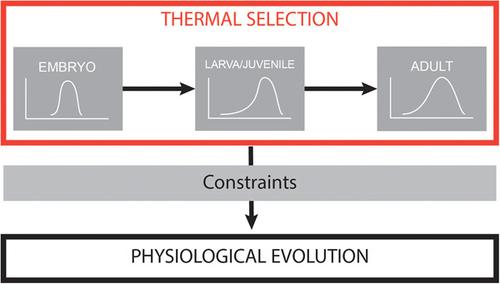当前位置:
X-MOL 学术
›
J. Exp. Zool. Part A
›
论文详情
Our official English website, www.x-mol.net, welcomes your
feedback! (Note: you will need to create a separate account there.)
Thermal adaptation revisited: How conserved are thermal traits of reptiles and amphibians?
Journal of Experimental Zoology Part A ( IF 1.9 ) Pub Date : 2020-09-24 , DOI: 10.1002/jez.2414 Brooke L Bodensteiner 1 , Gustavo A Agudelo-Cantero 2, 3 , A Z Andis Arietta 4 , Alex R Gunderson 5 , Martha M Muñoz 1 , Jeanine M Refsnider 6 , Eric J Gangloff 7
Journal of Experimental Zoology Part A ( IF 1.9 ) Pub Date : 2020-09-24 , DOI: 10.1002/jez.2414 Brooke L Bodensteiner 1 , Gustavo A Agudelo-Cantero 2, 3 , A Z Andis Arietta 4 , Alex R Gunderson 5 , Martha M Muñoz 1 , Jeanine M Refsnider 6 , Eric J Gangloff 7
Affiliation

|
Ectothermic animals, such as amphibians and reptiles, are particularly sensitive to rapidly warming global temperatures. One response in these organisms may be to evolve aspects of their thermal physiology. If this response is adaptive and can occur on the appropriate time scale, it may facilitate population or species persistence in the changed environments. However, thermal physiological traits have classically been thought to evolve too slowly to keep pace with environmental change in longer‐lived vertebrates. Even as empirical work of the mid‐20th century offers mixed support for conservatism in thermal physiological traits, the generalization of low evolutionary potential in thermal traits is commonly invoked. Here, we revisit this hypothesis to better understand the mechanisms guiding the timing and patterns of physiological evolution. Characterizing the potential interactions among evolution, plasticity, behavior, and ontogenetic shifts in thermal physiology is critical for accurate prediction of how organisms will respond to our rapidly warming world. Recent work provides evidence that thermal physiological traits are not as evolutionarily rigid as once believed, with many examples of divergence in several aspects of thermal physiology at multiple phylogenetic scales. However, slow rates of evolution are often still observed, particularly at the warm end of the thermal performance curve. Furthermore, the context‐specificity of many responses makes broad generalizations about the potential evolvability of traits tenuous. We outline potential factors and considerations that require closer scrutiny to understand and predict reptile and amphibian evolutionary responses to climate change, particularly regarding the underlying genetic architecture facilitating or limiting thermal evolution.
中文翻译:

再谈热适应:爬行动物和两栖动物的热性状如何保守?
两栖动物和爬行动物等发热动物对迅速变暖的全球温度特别敏感。这些生物的一种反应可能是演变其热生理学的各个方面。如果此响应是适应性的,并且可以在适当的时间范围内发生,则它可能有助于种群或物种在变化环境中的持久性。然而,传统上认为,热生理特征的演化太慢,以致无法与寿命更长的脊椎动物的环境变化保持同步。尽管20世纪中叶的经验工作为热生理性状的保守性提供了混合支持,但人们普遍呼吁对热性状的低进化潜力进行概括。在这里,我们重新审视这一假设,以更好地理解指导生理进化的时机和方式的机制。表征进化,可塑性,行为以及热生理学的个体发生变化之间的潜在相互作用,对于准确预测生物体将如何响应我们迅速变暖的世界至关重要。最近的工作提供了证据,表明热生理特性在进化上不像从前那样坚硬,在许多系统发育尺度上,热生理的几个方面都有许多分歧的例子。但是,通常仍观察到缓慢的演化速率,尤其是在热性能曲线的较热端。此外,许多响应的上下文特定性使得对特质的潜在可演化性的广泛概括变得脆弱。
更新日期:2020-09-24
中文翻译:

再谈热适应:爬行动物和两栖动物的热性状如何保守?
两栖动物和爬行动物等发热动物对迅速变暖的全球温度特别敏感。这些生物的一种反应可能是演变其热生理学的各个方面。如果此响应是适应性的,并且可以在适当的时间范围内发生,则它可能有助于种群或物种在变化环境中的持久性。然而,传统上认为,热生理特征的演化太慢,以致无法与寿命更长的脊椎动物的环境变化保持同步。尽管20世纪中叶的经验工作为热生理性状的保守性提供了混合支持,但人们普遍呼吁对热性状的低进化潜力进行概括。在这里,我们重新审视这一假设,以更好地理解指导生理进化的时机和方式的机制。表征进化,可塑性,行为以及热生理学的个体发生变化之间的潜在相互作用,对于准确预测生物体将如何响应我们迅速变暖的世界至关重要。最近的工作提供了证据,表明热生理特性在进化上不像从前那样坚硬,在许多系统发育尺度上,热生理的几个方面都有许多分歧的例子。但是,通常仍观察到缓慢的演化速率,尤其是在热性能曲线的较热端。此外,许多响应的上下文特定性使得对特质的潜在可演化性的广泛概括变得脆弱。











































 京公网安备 11010802027423号
京公网安备 11010802027423号